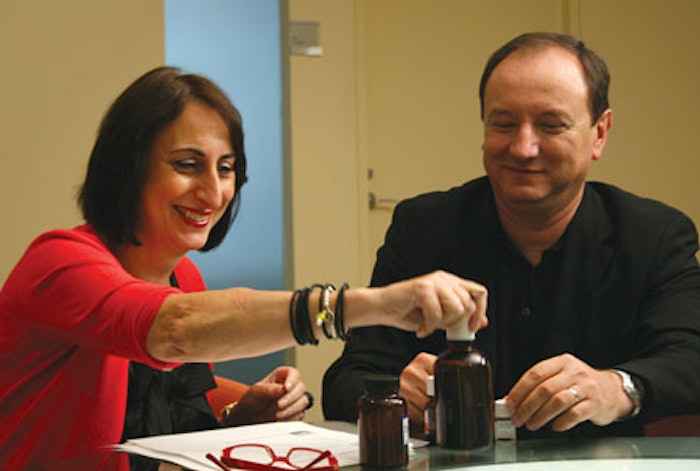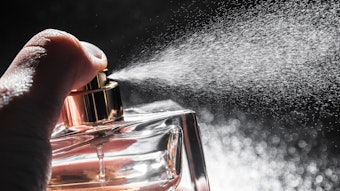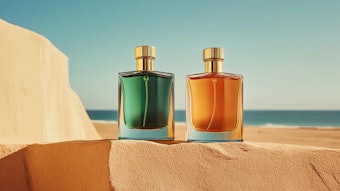
- Perfumers face increasing time constraints, forcing them to work differently than in past decades.
- Communication is very important, and there’s always something to learn from a consumer wearing the fragrance.
- The perfumer’s job is to interpret what is being asked for by the brand owner and to find what needs to be fixed in the formula to execute the idea. A finished scent is a result of a partnership.
Of the perhaps 3,000 novel aroma molecules created, assessed and vetted by Firmenich’s perfumers and R&D staff each year, perhaps as few as three will make their way onto the company palette.
“For a perfumer to discover a new material, it’s almost like a painter discovering a new color,” says master perfumer Harry Frémont, considering a blotter of the material. “Imagine what the artist could do. We use the new materials in different contexts, giving new effects.”
“The palette is so important,” says master perfumer Annie Buzantian. “You can use the same note over and over again in different contexts, but when you have something special in particular that you fall in love with, it gives a fragrance a soul.” These sorts of “exceptional notes,” she adds, can in many cases serve as founding inspirations for fragrances.
“When you have something that is exclusive to your company, it gives you a sense of confidence in what you do and what you show to the client,” says Frémont. “You feel you have something special. As a perfumer, it’s important to have this kind of confidence.” “We are a very much like architects,” says Buzantian. “We are influenced by new raw materials—a new construction material. It inspires you.”
Helvetolide are among these few raw materials that have made it onto Firmenich’s palette. The captive musk was discovered and commercialized in the 1990s,* and the somewhat ubiquitous material is markedly refined, making it generally more suitable for women’s fragrances than men’s scents. “It’s luxurious, elegant, classic, it smells expensive,” says Buzantian. “It’s like a cloud. It lends itself to floral notes, woody notes. I’ve used it in a woody complex, and people think it’s woody instead of musky. It has its own personality, but it lends itself to whatever else you want to work with. It’s very malleable. It’s like a chameleon.”
“It does wonders in a fragrance, from top note all the way to dry down, which is very important in a musk,” says Buzantian. Frémont notes: “Because some musks are very bottom-heavy, they flatten out fragrances. This one doesn’t.”
Finding Balance
Green notes are among Buzantian’s favorites, she says. Even used in small percentages, the ingredient packs a punch. Buzantian recently used this material in a fragrance at just a trace, and even then it was still too strong. “It’s very powerful, terribly potent,” she says. “It’s very strong on the blotter for a few days—one of those instances where you get great value for your money.” Buzantian finds the material useful in both men’s and women’s fragrances. “There’s almost a pineapple note, so it’s kind of fruity,” she says. “It makes for a beautiful signature. It gives you another edge, a new green nuance.” While its tenacity makes it useful in toiletry applications as well as fine fragrance, Buzantian explains that it requires balance. “Developing a fragrance is like composing a piece of music,” she says. “It’s all about harmony and balance.”
On Romance
“There is a point in your career where you feel more confident in what you do and you manage your challenges much better,” says Frémont. For him, Ralph Lauren Romance (1998) is that point—formulated 16 years into his career. “That’s when I felt my craft had arrived,” he says. “Also, I felt confident to talk about it and communicate. The hardest thing in this business is to take a fresh approach. At the time, I still had this naïve approach to [creation],” a state of mind he finds challenging to replicate at this stage of his career. Romance, he says, “is very multifaceted, but it has character at the same time. I discovered [in the ensuing] years that people were wearing the fragrance and describing it in different ways. To some people, it’s a fruity fragrance. [To others], it’s a chypre, and [for others], it’s a floral.” People talk about different parts of the fragrance when they talk about Romance.”
“It’s quite complex, visually,” says Frémont. “When we do a fragrance, we try to be very streamlined. With this one, there are a lot of layers that are all working together. When I did it, I didn’t see all those [facets].” At one point, Frémont explains, the fragrance was more extreme, aspects of which were refined throughout the process. He laughs, “When it all came together and became a success, it was an amazing experience.”
Craft Versus Art
“We take ownership of the fragrances we develop,” says Buzantian, “but in reality, we are only the co-authors of the fragrances [along] with our clients. We have few instances where we are the true creators of the fragrance; that is why Harry calls it a craft instead of an art. It’s a business. Let’s never forget that.”
This bit of pragmatism on Buzantian’s part stands in stark contrast to the unusual origins of her first designer fragrance win, the original Gianfranco Ferré scent, launched in 1984. “It is every perfumer’s dream to go from the collection into the bottle,” she says. “It happened without any modifications. It was a wonderful experience, but on the other hand, it was quite deceptive because it distorts the image of how difficult the creative process [typically] is.” The fragrance resulted from a modification of a jasmine musk she’d worked on at the very beginning of her career. Buzantian modernized the scent, adding new ingredients. This finished fragrance had the serendipitous fortune of meeting the client’s brief, which called for matching the scent of the flowers at his mountain villa. “It was more simplistic in its creation and put together more like a body care fragrance—having that stylized concept. The fragrance contains the sum of all the notes I love—white flowers, musk and all those things.”
Perseverance With a Smile: On Being a Perfumer
“Everything you do is a reflection of yourself,” says Buzantian, “even when you’re answering a brief that has to suit a certain client or requirement—you do it in your own style.” Everything filters through the individual’s collected experiences, knowledge and emotions—even as one meets the needs of the client. Buzantian explains that her eclectic training allowed her to define her own style. Frémont notes that he had a similar experience, recreating fragrances without a direct mentor to explain how a formula was supposed to look or be crafted. “It allows you to develop a style instead of inheriting someone else’s style,” Buzantian adds.
As master perfumers, both she and Frémont continue to help develop the next generation of perfumers, as well as fostering a continuing sense of teamwork and family within their company. Frémont explains that master perfumers bring a holistic vision of the fragrance business beyond creation. This vision is increasingly important, Buzantian notes, as today’s junior perfumers face increasing time constraints—the leisurely learning pace of past decades in which one might have had the time to explore numerous product categories and discover new insights is no more. And, she says, the less experience one has, the longer it takes to solve problems in a formulation, adding to the pressure on younger perfumers. Frémont notes that young perfumers will find that in the course of developing a fragrance one moves quickly past the aesthetic stage to the problem-solving stage. There, experience counts.
Meanwhile, Buzantian says, one must ensure that junior perfumers do not get too discouraged too early in their careers so that they give themselves a chance to “fall in love with it.” Certainly, a thick skin is required to get anywhere in the industry. Buzantian notes that the key lesson she has learned as a perfumer is “perseverance, with a smile.”
“There’s a fine line between conviction and being stubborn,” Frémont says of what he has learned. “Listening is very important. Communication is very important. You can be the best perfumer, but if you can’t communicate what you do—or understand what people are saying about your fragrance—it’s impossible. Sometimes [the client] sees something in the fragrance that you don’t because they experience the fragrance much more [fully] than we do. They’re launching one product and we’re working on [several] different ones. Their vision—even if it’s not technical—there’s always something to learn from a client or consumer wearing the fragrance and saying something about it. Our job is to interpret what is said, to find what needs to be fixed in the formula.” Buzantian adds, “[The clients] have a vision of where they want to go, and, in partnership, we are able to bring that vision to reality.”
Courtesy of Perfumer & Flavorist magazine (October 2009)
Jeb Gleason-Allured is the editor of Perfumer & Flavorist magazine.










